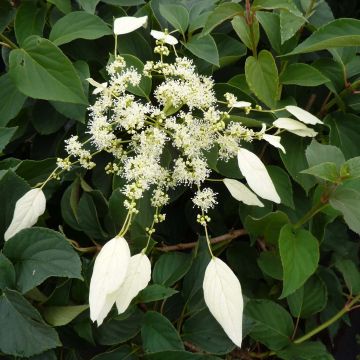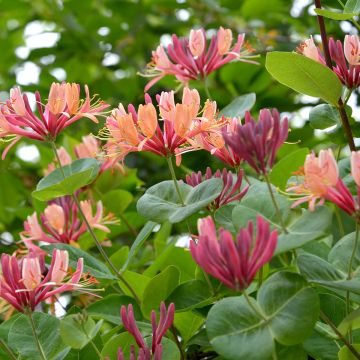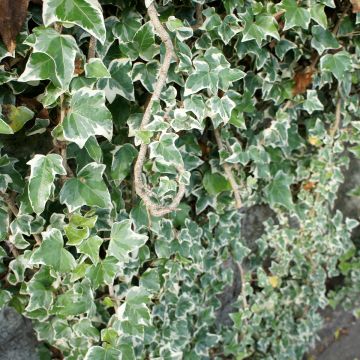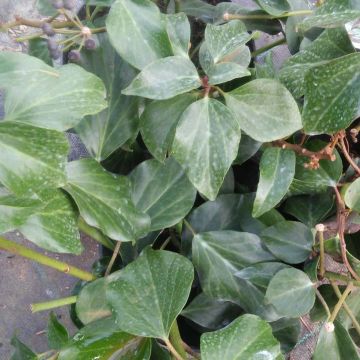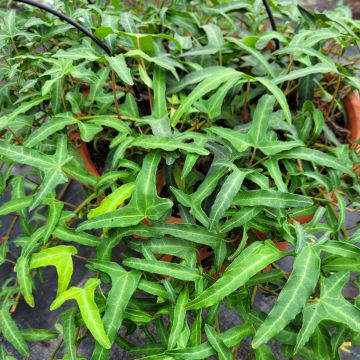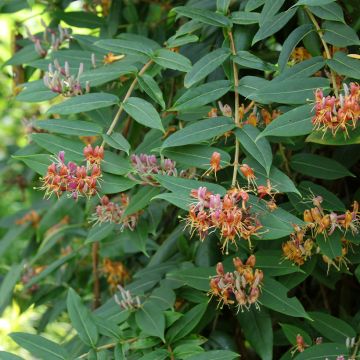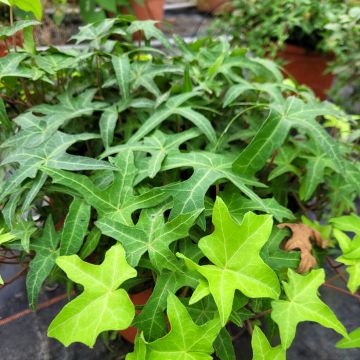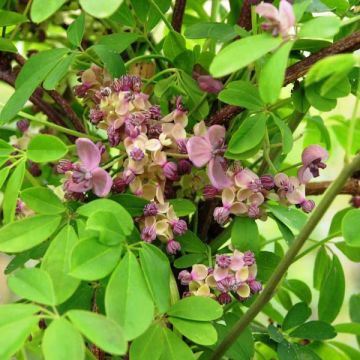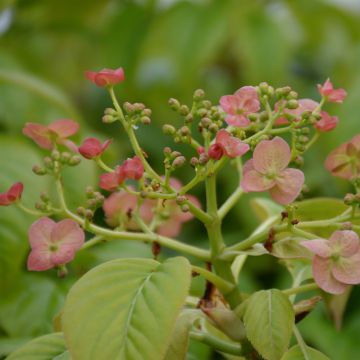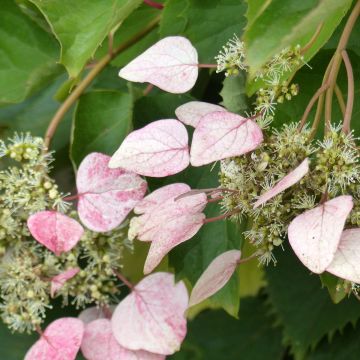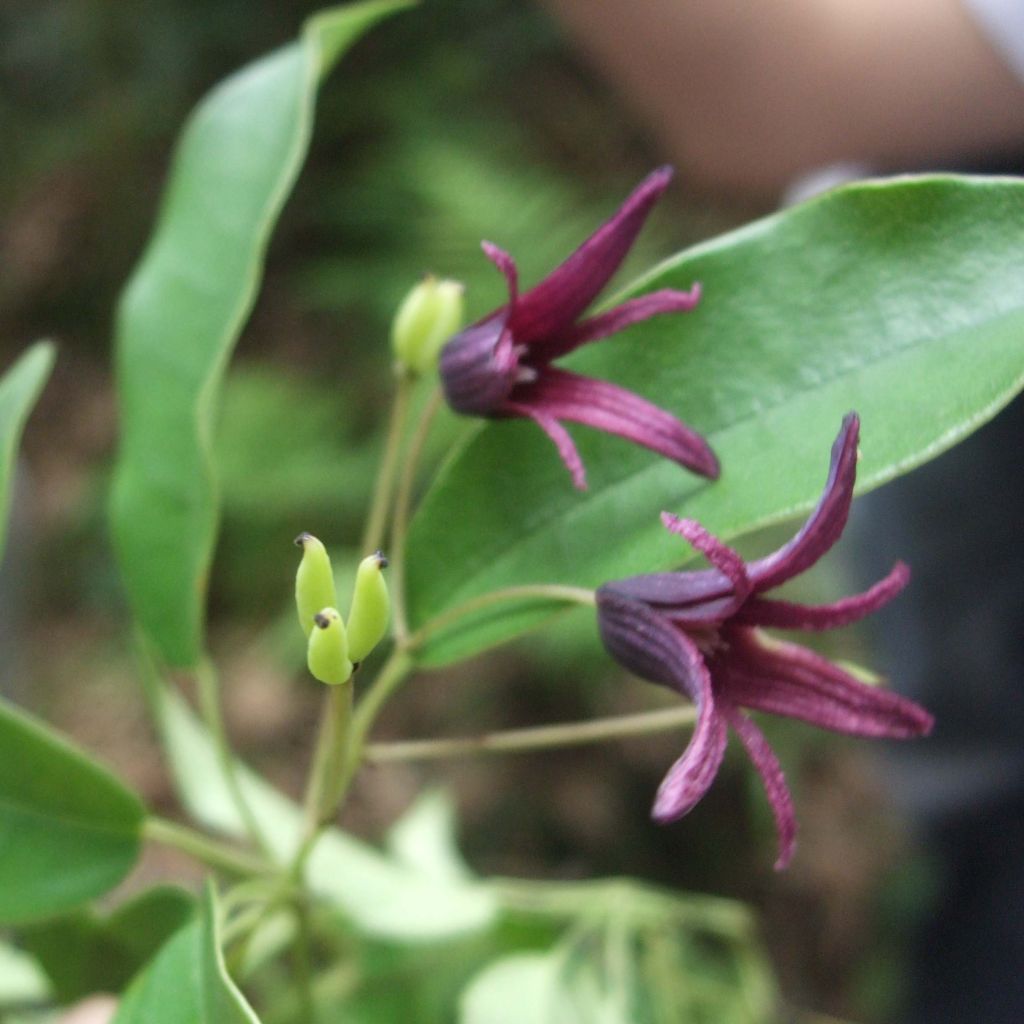

Stauntonia purpurea
Stauntonia purpurea
Stauntonia purpurea
This plant carries a 6 months recovery warranty
More information
We guarantee the quality of our plants for a full growing cycle, and will replace at our expense any plant that fails to recover under normal climatic and planting conditions.
From €5.90 for pickup delivery and €6.90 for home delivery
Express home delivery from €8.90.
Does this plant fit my garden?
Set up your Plantfit profile →
Description
The Stauntonia purpurea is a little-known vigorous climbing plant, but of great decorative value, resembling its cousins Akebia and Holboellia. This voluble plant is characterised by its lobed, evergreen and decorative foliage, and by its spring flowering with a penetrating rose fragrance, emanating from dark purple pendulous bells. A few edible fruits, purple then yellow at ripeness, are produced during the hottest summers. Moderately hardy, this plant is nonetheless easy to grow in shady positions, in rather moist, humus-rich, and slightly acidic soil.
The Stauntonia purpurea belongs to the Lardizabalaceae family. This monoecious climbing plant (with male and female flowers on the same subject) is native to Taiwan, where it grows in the valleys, dense forests, and among thickets, as well as along trails at altitudes between 1000 and 1600m (3281 and 5249ft). It is an evergreen woody vine, reaching a height of 5 to 7m (16 to 23ft), with a width of 3 to 4m (10 to 13ft). Its growth is rapid. The young branches and stems are green and striate, while older branches are covered with a rough grey-brown bark. Its leaves are compound, consisting of 5 ovate-oblong to elliptical, undulate leaflets, measuring 6 to 10cm (2 to 4in) in length and 2.5 to 4.5cm (1 to 2in) in width. They are green in colour and have a leathery appearance. This plant produces monoecious flowers in spring, in April-May, which are either male or female, very similar in shape to flared and curved bells, with the female flowers being slightly longer. They consist only of sepals, with a waxy texture and a penetrating fragrance. The flowers are grouped in small clusters of 3 to 7. The flowering is followed in autumn by the formation of a few purple, oval and verrucate fruits, measuring 5 to 6cm (2in) in length, which are edible if they ripen.
The Stauntonia transports us with its fragrance to distant horizons and vigorously winds itself, if allowed, to the top of small trees, exposing its small, colourful flowers that form a beautiful contrast with its luxuriant foliage. It requires a sheltered position in most climates. By training the voluble stems as they grow, this shade-loving plant can be used to adorn a garden shelter, a shaded pergola, or a large north-facing wall, as its vigour allows. It will accompany the Glycine floribunda 'Premature' in a Japanese scene, or blend with the flowering of Clematis montana and Japanese honeysuckles. This Stauntonia can also be cultivated in large containers, which can be protected from severe frosts.
Report an error about the product description
Stauntonia purpurea in pictures
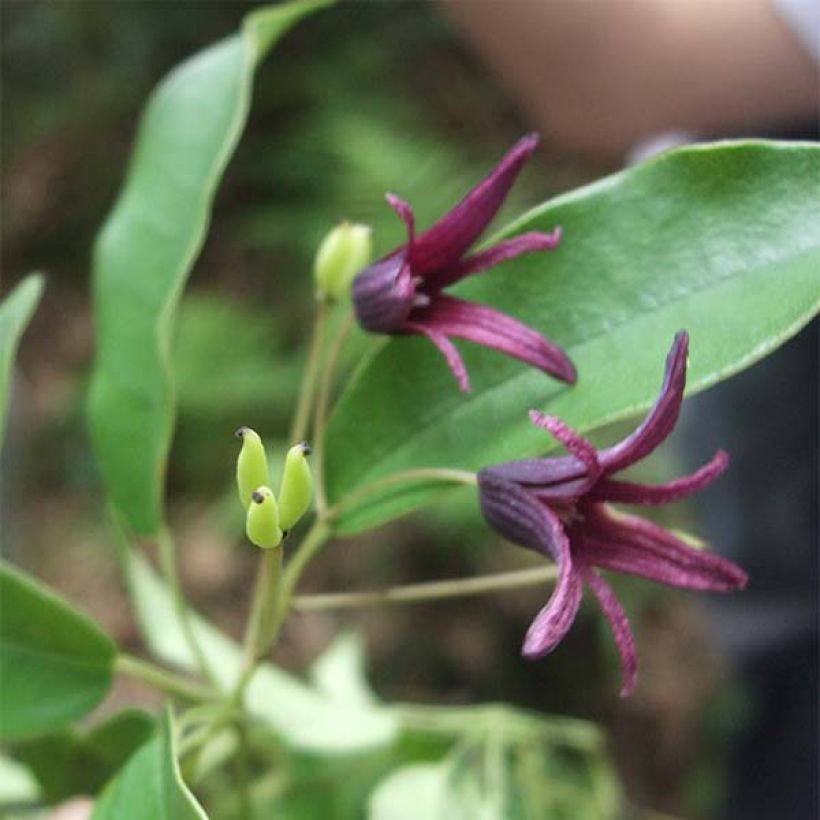

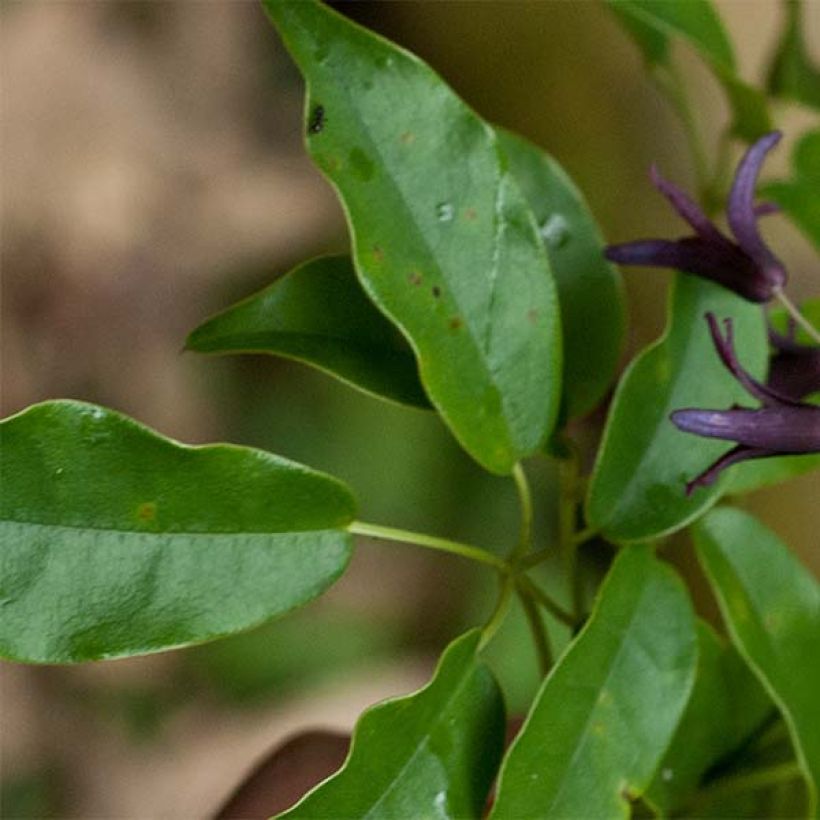

Plant habit
Flowering
Foliage
Botanical data
Stauntonia
purpurea
Lardizabalaceae
Southeast Asia
Planting and care
Install the Stauntonia purpurea in a shaded, well-sheltered area protected from prevailing winds. A plant that has been in the ground for several years will better withstand the cold (to -10°C (14°F)). It adapts to semi-shade and even shady situations. Plant it in well-drained, fertile soil rich in humus, low in limestone, and that remains fairly moist. Growing it in a pot is easy and allows you to protect the plant from severe frost. Lighten the substrate by incorporating clay pellets or gravel at the bottom of the pot or planting hole. The mixture could consist, for example, of 1/3 compost, 1/3 garden soil, and 1/3 manure. Train the plant as it grows. Water regularly, especially in hot and dry weather. The Stauntonia does not require any particular pruning, but you can prune it to control its vigorous growth. A tip: prune the young shoots to just 2 or 3 leaves, as this is where the flowers for the following year will appear!
Planting period
Intended location
Care
This item has not been reviewed yet - be the first to leave a review about it.
Shade-loving climbers
Haven't found what you were looking for?
Hardiness is the lowest winter temperature a plant can endure without suffering serious damage or even dying. However, hardiness is affected by location (a sheltered area, such as a patio), protection (winter cover) and soil type (hardiness is improved by well-drained soil).

Photo Sharing Terms & Conditions
In order to encourage gardeners to interact and share their experiences, Promesse de fleurs offers various media enabling content to be uploaded onto its Site - in particular via the ‘Photo sharing’ module.
The User agrees to refrain from:
- Posting any content that is illegal, prejudicial, insulting, racist, inciteful to hatred, revisionist, contrary to public decency, that infringes on privacy or on the privacy rights of third parties, in particular the publicity rights of persons and goods, intellectual property rights, or the right to privacy.
- Submitting content on behalf of a third party;
- Impersonate the identity of a third party and/or publish any personal information about a third party;
In general, the User undertakes to refrain from any unethical behaviour.
All Content (in particular text, comments, files, images, photos, videos, creative works, etc.), which may be subject to property or intellectual property rights, image or other private rights, shall remain the property of the User, subject to the limited rights granted by the terms of the licence granted by Promesse de fleurs as stated below. Users are at liberty to publish or not to publish such Content on the Site, notably via the ‘Photo Sharing’ facility, and accept that this Content shall be made public and freely accessible, notably on the Internet.
Users further acknowledge, undertake to have ,and guarantee that they hold all necessary rights and permissions to publish such material on the Site, in particular with regard to the legislation in force pertaining to any privacy, property, intellectual property, image, or contractual rights, or rights of any other nature. By publishing such Content on the Site, Users acknowledge accepting full liability as publishers of the Content within the meaning of the law, and grant Promesse de fleurs, free of charge, an inclusive, worldwide licence for the said Content for the entire duration of its publication, including all reproduction, representation, up/downloading, displaying, performing, transmission, and storage rights.
Users also grant permission for their name to be linked to the Content and accept that this link may not always be made available.
By engaging in posting material, Users consent to their Content becoming automatically accessible on the Internet, in particular on other sites and/or blogs and/or web pages of the Promesse de fleurs site, including in particular social pages and the Promesse de fleurs catalogue.
Users may secure the removal of entrusted content free of charge by issuing a simple request via our contact form.
The flowering period indicated on our website applies to countries and regions located in USDA zone 8 (France, the United Kingdom, Ireland, the Netherlands, etc.)
It will vary according to where you live:
- In zones 9 to 10 (Italy, Spain, Greece, etc.), flowering will occur about 2 to 4 weeks earlier.
- In zones 6 to 7 (Germany, Poland, Slovenia, and lower mountainous regions), flowering will be delayed by 2 to 3 weeks.
- In zone 5 (Central Europe, Scandinavia), blooming will be delayed by 3 to 5 weeks.
In temperate climates, pruning of spring-flowering shrubs (forsythia, spireas, etc.) should be done just after flowering.
Pruning of summer-flowering shrubs (Indian Lilac, Perovskia, etc.) can be done in winter or spring.
In cold regions as well as with frost-sensitive plants, avoid pruning too early when severe frosts may still occur.
The planting period indicated on our website applies to countries and regions located in USDA zone 8 (France, United Kingdom, Ireland, Netherlands).
It will vary according to where you live:
- In Mediterranean zones (Marseille, Madrid, Milan, etc.), autumn and winter are the best planting periods.
- In continental zones (Strasbourg, Munich, Vienna, etc.), delay planting by 2 to 3 weeks in spring and bring it forward by 2 to 4 weeks in autumn.
- In mountainous regions (the Alps, Pyrenees, Carpathians, etc.), it is best to plant in late spring (May-June) or late summer (August-September).
The harvesting period indicated on our website applies to countries and regions in USDA zone 8 (France, England, Ireland, the Netherlands).
In colder areas (Scandinavia, Poland, Austria...) fruit and vegetable harvests are likely to be delayed by 3-4 weeks.
In warmer areas (Italy, Spain, Greece, etc.), harvesting will probably take place earlier, depending on weather conditions.
The sowing periods indicated on our website apply to countries and regions within USDA Zone 8 (France, UK, Ireland, Netherlands).
In colder areas (Scandinavia, Poland, Austria...), delay any outdoor sowing by 3-4 weeks, or sow under glass.
In warmer climes (Italy, Spain, Greece, etc.), bring outdoor sowing forward by a few weeks.




































